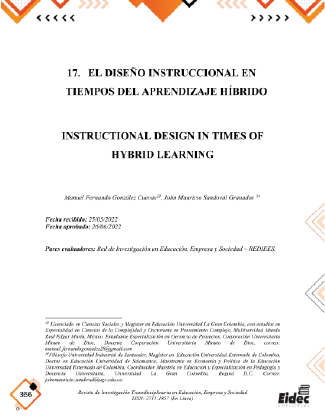XVII. INSTRUCTIONAL DESIGN IN TIMES OF HYBRID LEARNING
##plugins.themes.bootstrap3.article.main##
Abstract
The commercial expansion of electronic devices, the expansion of networks that
enable access to the Internet and bring with them the possibility of connecting in real time
with people in various geographical scenarios, as well as allowing the consultation of diverse
sources of information in multiple institutions, profoundly altering the way in which people
and individuals relate to information and the knowledge society.
This approach seemed to be developing in a partial way, motivated only by the
challenges of the working world and stimulated by the market, but a health situation would
come up that would disrupt this paradigmatic bet, with incredible brevity the COVID 19
virus, became a pandemic that provided an initial isolation, same that questioned the
separation of population groups and for the school enacted a new interaction based on the
connection through virtual platforms.
Emanating from this transformation and strengthened by health care standards, a
gradual return to school institutions at all levels was developed, which does not imply a return
to the education, practices and didactic sequencing that took place prior to the pandemic, but
rather imbricate a new daily life and teaching praxis, due to the transformation of practices
that led to the overcoming of isolation and the insertion of technologies in the school field.
In this way, technological development and student training converge to form a hybrid
learning system that combines the availability of ICT resources with the experience of faceto-face education
Download Statistics
##plugins.themes.bootstrap3.article.details##
Hybrid learning, Online education, Instructional design, Face-to-face education
investigación cualitativa. XIKUA Boletín Científico De La Escuela Superior De
Tlahuelilpan, 2(3). https://bit.ly/3lOsDkg
Belloch, C. (2007, 12 de septiembre) Diseño instruccional. Unidad de Tecnología Educativa.
Universidad de Valencia. https://bit.ly/3wSaNBR
Fredin, E. (2017, 13 de octubre). Aprendizaje híbrido: ¿el futuro de la educación superior?
Instituto para el futuro de la educación. Observatorio. Tecnológico de Monterrey.
https://bit.ly/3MAemmU
Gómez, J. (2004) La recopilación documental. Para qué y cómo documentarse en Ciencias
de la Información Documental. En J., Gómez (Ed) Metodologías de investigación en
Información y Documentación(pp. 33-69). Ediciones Universidad de Salamanca.
https://bit.ly/3PLsUlr
Góngora, Y. y Martínez, O. (2012). Del diseño instruccional al diseño de aprendizaje con
aplicación de las tecnologías. Revista Teoría de la Educación. Educación y Cultura
en la Sociedad de la Información, 13 (3), 342 – 360. https://bit.ly/3MYe5dB
Londoño, E. (2011) El diseño instruccional en la educación virtual: Más allá de la
presentación de contenidos. Revista Educación y Desarrollo Social, 6(2), 112-127.
https://bit.ly/3lrpiHs
Sánchez, M., García, J., Steffens, E. y Hernández, H. (2019). Estrategias Pedagógicas en
Procesos de Enseñanza y Aprendizaje en la Educación Superior incluyendo
Tecnologías de la Información y las Comunicaciones. Revista Información
Tecnológica, 30(3), 277-286. https://bit.ly/3lA1KQB
Streb, N. (2020, 13 de abril) Diario De Un Estudiante En Cuarentena.
https://bit.ly/3wN6b0Z
Universidad de la Sabana (s.f.) Desafío y oportunidades del aprendizaje híbrido. Campus
Unisabana. https://bit.ly/3z0cEHq





